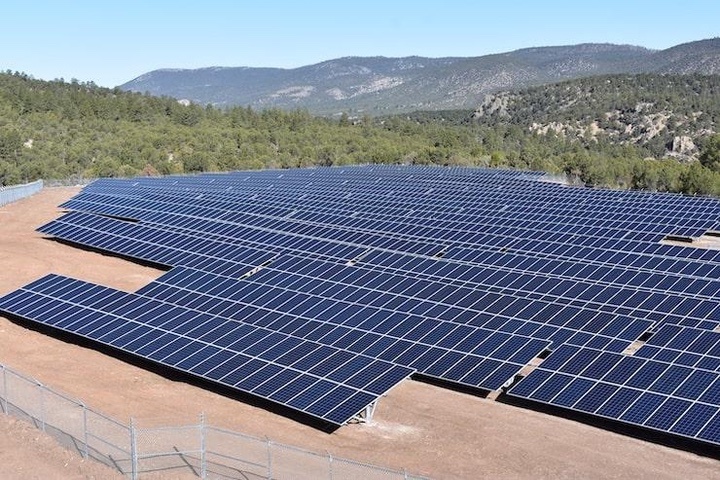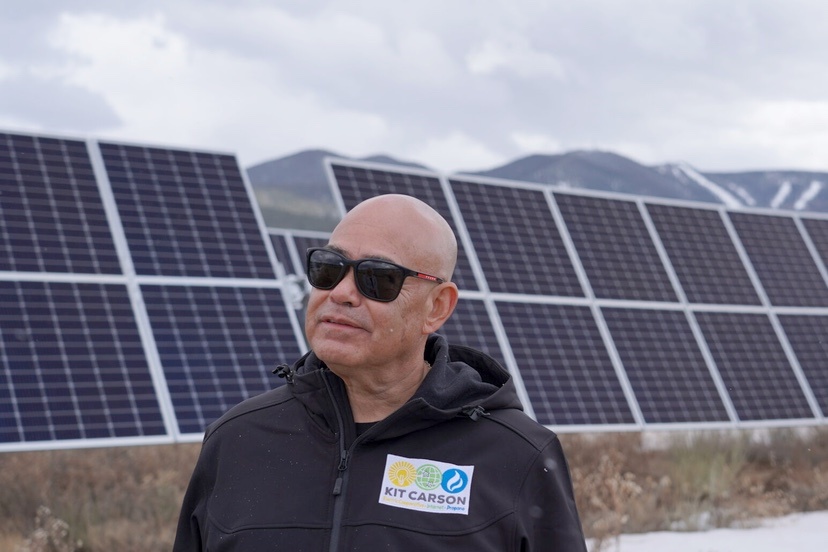Photo: Kit Carson Electric CEO Luis A. Reyes Jr. (Courtesy Kit Carson Electric)
This story is excerpted from an article by Allen Best on BigPivots.com on October 3, 2014. Read the full article here.
As a boy in northern New Mexico, Luis Reyes Jr. thought he might someday work at a molybdenum mine in Questa. In a way, he finally is, except that the mine has been closed now for a decade.
Instead of mining for molybdenum there at the foot of the Sangre de Cristo Range, Reyes hopes to make green hydrogen. Kit Carson, the electrical cooperative he manages, announced this week that it expects to get a $96.5 million federal grant to supplement a $500,000 federal grant received earlier this year for the enterprise.
Reyes has enough confidence the project will happen that he projects a ribbon-snipping to mark the ground-breaking in 2027.
“We have a track record of doing things that are the very first and being successful, and it’s time to go to the next level,” he said in a telephone interview. “I am confident that we can get this done.”
Kit Carson can find no direct precedent for the project in the United States, although there may be green hydrogen projects of a similar nature in Europe. It is to use renewable electricity to power an electrolyzer that will produce the hydrogen from water drawn from the now-abandoned underground mine. Hydrogen can be made from natural gas, and there are several of those projects in the United States, but no green hydrogen projects.
The result will be green hydrogen that in effect will give Kit Carson a 24-hour battery. It already has 16.25 megawatts of lithium-ion battery storage scattered across its service territory near its headquarters in Taos and other places in northern New Mexico. It also has 41 megawatts of solar resources distributed across that area.
The green hydrogen, says Reyes, will give Kit Carson energy storage that will last four to six times as long as the lithium-ion batteries it already has. That, he says, could be useful in event of future forest fires or even the extreme weather that has become more common.
The National Renewable Energy Laboratory conducted the feasibility study of the project in conjunction with Kit Carson.
Reyes grew up in Taos, and for a time thought he might someday work at the mine at Questa, located a half-hour north. The molybdenum mine paid reasonably well. He had always done well in school but not until his junior year did he give any thought to attending college. Education was not emphasized in his household.
The first in his family to do so, Reyes did go to college, returning to Taos with a degree in electrical engineering. He went to work for Kit Carson and, in time, became general manager. He’s formally now the chief executive.
In recent years, Kit Carson Electric Cooperative has gained regional and even national attention as a leader in the energy transition. First was the decision to leave Tri-State Generation and Transmission Association. The wholesale supplier had been slow to loosen its embrace of coal. It also had sharply limited what its then 44 member cooperatives in Colorado, New Mexico and other states could do on their own. The contract limited the electrical generation of members to just 5% of their total demand.
Privately, according to utility directors who attended Tri-State meetings at the time, some in the utility sector wondered whether Kit Carson would fall on its face. Instead, it has thrived since gaining independence in 2016.
By June 2022, the cooperative achieved two milestones. One was the final payment on the $37 million it cost to break its all-requirement contract with Tri-State. During that same time, it had also developed enough solar capacity in its service territory in northern New Mexico to meet 100% of its daytime needs.

How about when it’s cloudy or the sun sets? Kit Carson has a strong ally, Denver-based Guzman Energy. Guzman helped finance Kit Carson’s exit from Tri-State. It also provided backup power for Kit Carson as the electrical cooperative developed its own. Guzman still does, even as Kit Carson has continued to work on expanding its self-reliance.
About three years ago, Kit Carson embarked on a related ambition. Reyes and his team had concluded that they wanted to create a green hydrogen project. The revised contract with Guzman in 2019 expressly acknowledged this and other possible technology innovations. Meetings were held, stakeholders consulted.
The award announced this week will allow Kit Carson to move forward with the planning, design and construction of the green hydrogen electric facility at Questa and two other locations.
Officially, Kit Carson is still a finalist, but in practice that means it’s just a whisker away from seeing money from the New ERA program funded by Congress in the Inflation Reduction Act. In Colorado, Tri-State, United Power, and CORE Electrical Cooperative also are getting close to $1.1 billion in assistance through the program.
Kit Carson now has a goal of securing more than 70% of its electricity from renewable sources by 2028. Today, 55% to 60% of Kit Carson’s energy is emissions free. The cooperative wants to ultimately achieve 100% emissions-free electricity, although it has not set a target date for achieving that goal.
Reyes traces his thinking about hydrogen to 2000. The now defunct Enron was aggressively expansionist, threatening to undermine the sole mission of Kit Carson since its creation, of delivering electricity. That caused Kit Carson to form two new divisions. One was to deliver what is now called its broadband division; then it was just the Internet. It also created delivery of propane to rural homes.
Kit Carson at the time considered how to draw hydrogen out of the propane. It would have been blue hydrogen, as hydrogen made from a fossil fuel is called. That idea never went anywhere, though. “The technology just didn’t come to be,” said Reyes when I talked to him by phone as I do maybe once a year.
About three years ago Kit Carson came up with the new idea of using renewable energy to convert this water tainted by pollution to address storage, a challenge confronting all electrical utilities as they stretch to reduce their carbon emissions.
The molybdenum mine at Questa that was operated by Chevron at one time had a work force of 1,000 people. Employment slackened to 350 over the decades as molybdenum demand was more easily met in expanded copper-mining operations in the United States and elsewhere. The same market conditions have slowed production at Colorado’s two big molybdenum mines, Climax and Henderson.
Unlike the Colorado molybdenum mines, the mine at Questa was closed altogether in 2014. It produces a million gallons of water a day. Kit Carson calculates that six acre-feet of water at Questa will be needed for production of 15 megawatt-hours of green hydrogen. That green hydrogen can, in turn, be used to generate electricity for 24 hours.
“Our model is 24 hours, but if we had more storage capacity, which means more water, we could go 10 days,” Reyes said. “If you are in another part of the county with more water, you could go a couple of weeks.”
Allen Best publishes the e-journal Big Pivots, which chronicles the energy transition in Colorado and beyond.

